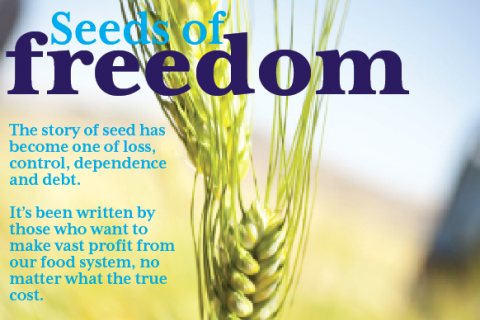The events of June 6, 1984, have been branded in the Sikh memory as a full-out attack against the Sikh identity. With the temporary destruction of one of the most sacred sites in the Sikh religion, and with thousands of lives lost, no one can deny that the Sikh community suffered greatly that day, and in the years to follow.
Yet, when we dig into history a bit further, and look at the forces at play in Punjab prior to this volatile time, something critically important emerges. Water. Seeds. Land. Food - the essence of life. These forces lie at the foundation of the regional conflict in Punjab.
There is an old saying here in New Mexico. “Whiskey is for drinking and water is for fighting.” Not that I am condoning drinking whiskey. However, it is a colloquialism that means wherever water is scarce, people fight over it.
My sense from understanding the history of this time echoes these sentiments. Issues of water rights in Punjab preceded the physical conflict. Water is the source of life, of prosperity, of social organization, and of power. Where there is access to water, people live in peace. When competition for water increases, people go to war. Who those people are, what names they give themselves, what tribe they belong to, what religion, what culture - all of that is a kind of window dressing. It is the pressure of protecting one’s access to water that creates deep and violent conflict.
As climate change continues to happen, and water resources become even more pressurized, we may see a pattern develop across the globe. Fights for access to resources will get rebranded as “sectarian” conflicts. When it is a question of one group of people fighting against another group of people, then both sides operate to defend their positions, and resolution can become difficult to find.
Yet, if we are willing to step back and look at the resource pressures behind the fighting, we may be able to see a road to healing - how we can restore balance and harmony.
There was a fight over water in Punjab. And the fight escalated into an attack on the Akal Takhat.
But the question is - what was behind the increased demand for water? What created the pressure on this precious resource to begin with? Was it population pressure? Was it drought?
Why did the demand for water increase in such a way as to develop these conflicts to begin with?
 Surprisingly - the answer has nothing to do with the Indian government, or with the Sikhs. It has to do with seeds. Specifically, the seeds coming from the United States as part of the “Green Revolution.”
Surprisingly - the answer has nothing to do with the Indian government, or with the Sikhs. It has to do with seeds. Specifically, the seeds coming from the United States as part of the “Green Revolution.”
Seed and agricultural activist Vandana Shiva wrote a book in 1991 titled, “The Violence of the Green Revolution,” which includes a discussion of how the Green Revolution impacted Punjab. It is a long book, filled with charts and facts, but I wanted to highlight a couple key issues that seemed important as we reflect on the 30th Anniversary of 1984. In the book, Ms. Shiva describes how agriculture was traditionally practiced in Punjab.
Prior to the Green Revolution, Punjab had an amazingly diverse agricultural system based on seeds which worked in harmony with their own environment. Although there were irrigation systems in place for the seeds, the seeds did not necessarily need extra water. The additional irrigation served as a kind of “insurance” to support the seeds’ growth.
“As in the rest of India, indigenous agriculture in Punjab was based on diversity,” Shiva writes.” Among the non-food crops indigo, sugarcane, cotton, hemp, assafoetida and oilseeds were grown. The horticultural crops included guavas, dates, mangoes, limes, lemons, peaches, apricots, figs, pomegranates, plums, oranges, mulberries, grapes, almonds, melons, apples, beans, cucumbers, carrots and turnips The uncultivated areas were covered by date-palm, wild palm, willows acacias, sisso, byr apple, etc.
“The millets...occupied the largest area under cultivation in Punjab...covering 43% of the area. Besides these, there were uncultivated or wild varieties of millet. Closely related to the millets were lesser known crops like amaranth of which Punjab had a rich diversity….” (Pages 81-82)
And the description goes on and on.
Like indigenous communities around the world, the farmers of Punjab had spent generations developing a diversity of seeds that could easily grow in their native environment. Seeds, in time, produced the food to support those who grew them. This created the prosperity for which Punjab was so famous.
Yet, once the seeds from the United States came to Punjab as part of the Green Revolution, agriculture in the area underwent a radical change.
“The Green Revolution...seeds have an enormous thirst for irrigation water. Compared to the earlier varieties needing protective irrigation as an insurance against crop failures, the new seeds need intensive irrigation as an essential input for crop yields. The Green Revolution increased the need for irrigation water at two levels. Firstly, the shift from water prudent crops such as millets and oilseeds to monocultures and multicropping such as wheat and rice increased the demand for water inputs throughout the year...Secondly, the replacement of old varieties of wheat with new varieties of wheat and rice also increased the intensity of irrigation, which went up from 20-30% to 200-300%.
“Irrigation, which used to be protective, now became ‘productive.’ Green Revolution varieties need much more water than indigenous varieties. High Yielding Varieties of wheat, for example, need about three times as much irrigation as traditional varieties...The dramatic increase in water use with the Green Revolution has led to a total destabilisation of the water balance in the region.” (Page 125)
Violence becomes a cycle within itself. The dialogue around 1984 veers in so many different directions, but essentially it is an argument within the Sikh community about how Sikhs can establish a safe and secure future.
Yet, the true roots of the conflict in Punjab is not about the Sikh identity at it's root. They have to do with the colonization of the land by seeds that created a tremendous imbalance in the natural resources. Nowhere in any of the conversations about 1984 has this added dimension become a major topic of conversation.
The fight over water did not just materialize out of thin air. The fight over water came from a globalization policy that demanded indigenous farmers in Punjab and other regions around the world to abandon the agricultural practices that had worked for hundreds of year. The Sikhs had to throw away the seeds they had bred for generations, which harmonized with the environment, and plant “high yield” seeds that demanded more than the environment ultimately had to give.
This inability to see the forest for the trees, so to speak, has led directly to the current crisis we see in Punjab today. Now, the farmers in Punjab have planted Genetically Modified (GMO) seeds with devastating results - crop failure and high debt. A generation ago, the imbalance of the seeds with the environment turned into outward violence. During this generation, the violence has turned inwards. The Sikh farmers are no longer fighting another group of people. They are simply committing suicide.
I would like to propose that as long as we limit the dialogue and focus of 1984 to the violence that happened, we will never be able to heal the roots of the conflict. The problems in Punjab have to do with the same problems in countries around the world. We have abandoned the seeds that exist in harmony with the environment to plant seeds that ultimately devastate the environment. And since people are the manifestation of seeds, human communities eventually embody that imbalance and devastation.
From this perspective, the source of the conflict is actually not the Sikh identity. The Sikh identity is collateral damage in the fight. The conflict begins with the ecology.
Could organic farming practices with traditional seeds save Punjab, and thereby, save the Sikh identity? That might be simplifying the issue too much. Yet, if one kind of seed began the tremendous environmental imbalance that lead to social unrest and violence; another type of seed that restores the balance within the environment may lead to peace and a strengthening of the community. Ultimately, that is an experiment that this and future generations will have to undertake with our own hands and our own lives. If the land can be restored, then the Sikh identity may very well have the foundation to thrive again.





